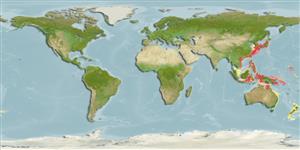Klassifizierung / Names
Namen | Synonyme | Catalog of Fishes(Gattung, Arten) | ITIS | CoL | WoRMS | Cloffa
>
Perciformes/Serranoidei (Groupers) >
Serranidae (Sea basses: groupers and fairy basslets)
Etymology: Chelidoperca: Greek, chelidon, -onos = swift, as black as a swift + Greek, perke = perch (Ref. 45335); tosaensis: Named for its type locality. Tosa Bay, Kochi Prefecture, Japan..
Environment: milieu / climate zone / depth range / distribution range
Ökologie
seewasser riff-verbunden; tiefenbereich 60 - 302 m (Ref. 117302). Subtropical
Western Pacific: Japan and northern East China Sea and the Philippines.
Size / Gewicht / Alter
Maturity: Lm ? range ? - ? cm
Max length : 8.3 cm SL Männchen/unbestimmt; (Ref. 117302)
Kurzbeschreibung
Morphologie | Morphometrie
Rückenflossenstacheln (insgesamt): 10; Rückenflossenweichstrahlen (insgesamt): 9-10; Afterflossenstacheln 2-3; Afterflossenweichstrahlen: 6 - 7. This species is distinguished from its congeners by the following set of characters: pectoral-fin rays 14-16 (modally 15); pored lateral-line scales 37-42 (39); scale rows in longitudinal series 39-43 (40); scale rows between lateral line and base of sixth dorsal-fin spine 3; serrae - preopercular 15-40, interopercular 3-19, subopercular 5-20; interorbital scales reaching to or extending slightly beyond the mid-orbit level, but not extending beyond anterior margin of orbit; scales on ventral surface of lower jaw confined to angular, none on dentary; relatively long dorsal- and anal-fin soft rays, penultimate dorsal-fin soft ray 15.9-25.7 (21.1) % of SL, longest dorsal-fin soft ray 16.4-25.7 (21.4) % of SL, penultimate anal-fin soft ray 18.2-26.4 (22.0) % of SL and longest anal-fin soft ray 18.2-26.4 (22.0) % of SL; dorsal-fin has numerous small yellow spots scattered over fin in irregularly diagonal rows, several small to large red blotches forming reddish diagonal streak from middle of 3rd or 4th spine to base of 5th or 6th spine; anal fin has small yellow spots scattered basally and centrally over posterior half of fin; caudal fin with about 3 irregular columns of small yellow spots alternating with columns of whitish spots on central and distal portions of fin, and about 2 narrow columns of red spots on interradial membranes of basal portion of lower lobe of fin, plus a pair of large poorly defined white blotches on fin base with a pair of small yellow blotches between them; large ocellated red spot on opercular membrane; side of body with longitudinal row of about 4 dark red elongate blotches (Ref. 117302).
Life cycle and mating behavior
Geschlechtsreife | Fortpflanzung | Ablaichen | Eier | Fecundity | Larven
Matsunuma, M., T. Yamakawa and J.T. Williams, 2018. Chelidoperca tosaensis, a new species of perchlet (Serranidae) from Japan and the Philippines, with geographic range extension of C. stella to the northwestern Pacific Ocean. Ichthyol. Res. 65:210-230. (Ref. 117302)
IUCN Rote Liste Status (Ref. 130435)
Bedrohung für Menschen
Harmless
Nutzung durch Menschen
Mehr Information
NamenSynonymeMetabolismusRäuberÖkotoxikologieFortpflanzungGeschlechtsreifeAblaichenSpawning aggregationFecundityEierEientwicklung
Alter/GrößeWachstumLänge-GewichtLänge-LängeLängenhäufigkeitenMorphometrieMorphologieLarvenLarven Pop.Dyn.RekrutierungDichteBRUVS
ReferenzenAquakulturAquakultur ProfilZuchtlinienGenetikElectrophoresesVererbbarkeitKrankheitenVerarbeitungNutrientsMass conversion
PartnerBilderStamps, Coins Misc.LauteCiguateraGeschwindigkeitSchwimmstilKiemenoberflächeOtolithsGehirngrößeSehfähigkeit
Tools
Zusatzinformationen
Download XML
Internet Quellen
Estimates based on models
Phylogenetic diversity index (Ref.
82804): PD
50 = 0.5010 [Uniqueness, from 0.5 = low to 2.0 = high].
Bayesian length-weight: a=0.01072 (0.00509 - 0.02256), b=3.06 (2.88 - 3.24), in cm total length, based on LWR estimates for this (Sub)family-body shape (Ref.
93245).
Trophic level (Ref.
69278): 3.5 ±0.5 se; based on size and trophs of closest relatives
Widerstandsfähigkeit (Ref.
120179): hoch, Verdopplung der Population dauert weniger als 15 Monate. (Preliminary K or Fecundity.).
Fishing Vulnerability (Ref.
59153): Low vulnerability (10 of 100).
